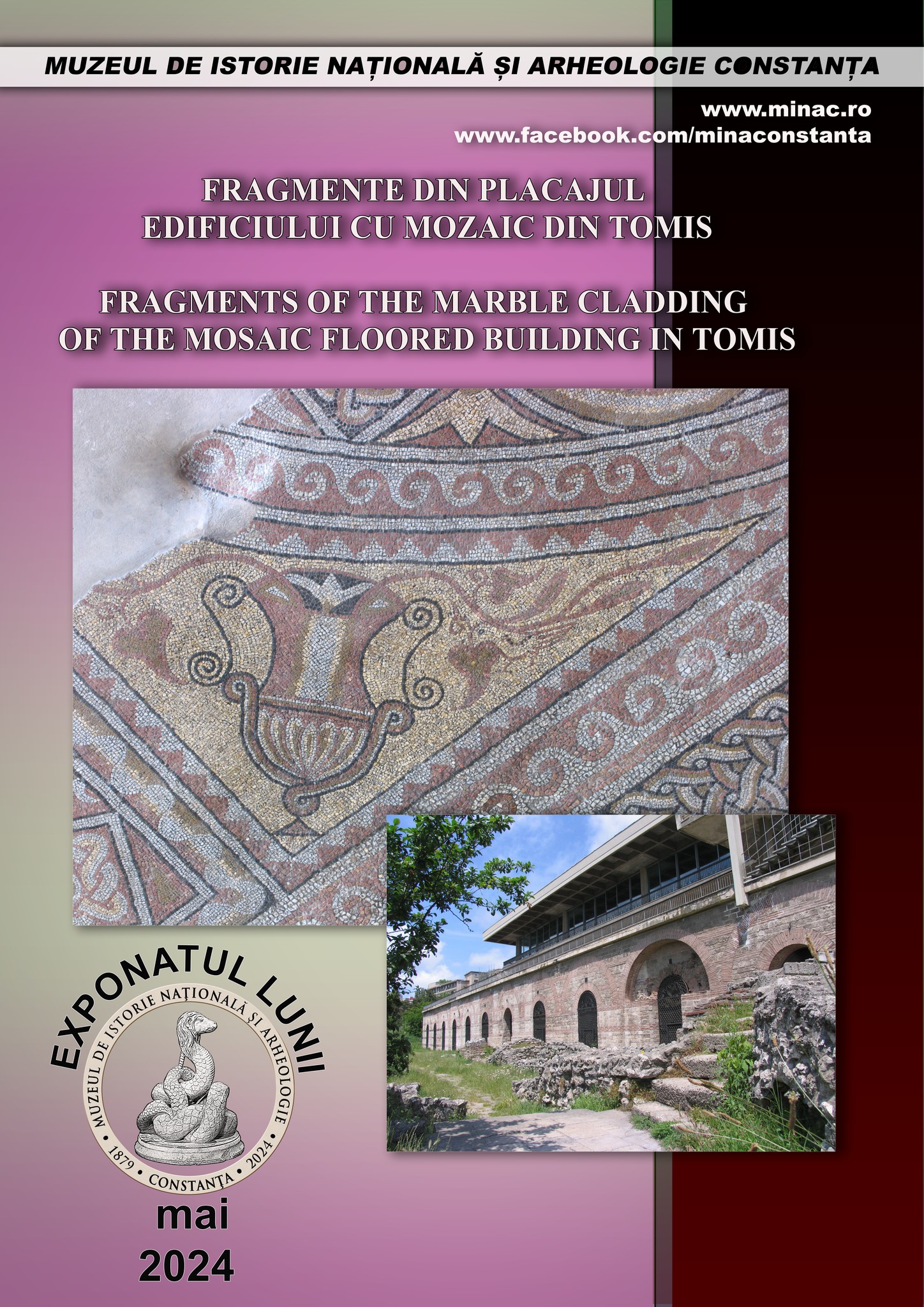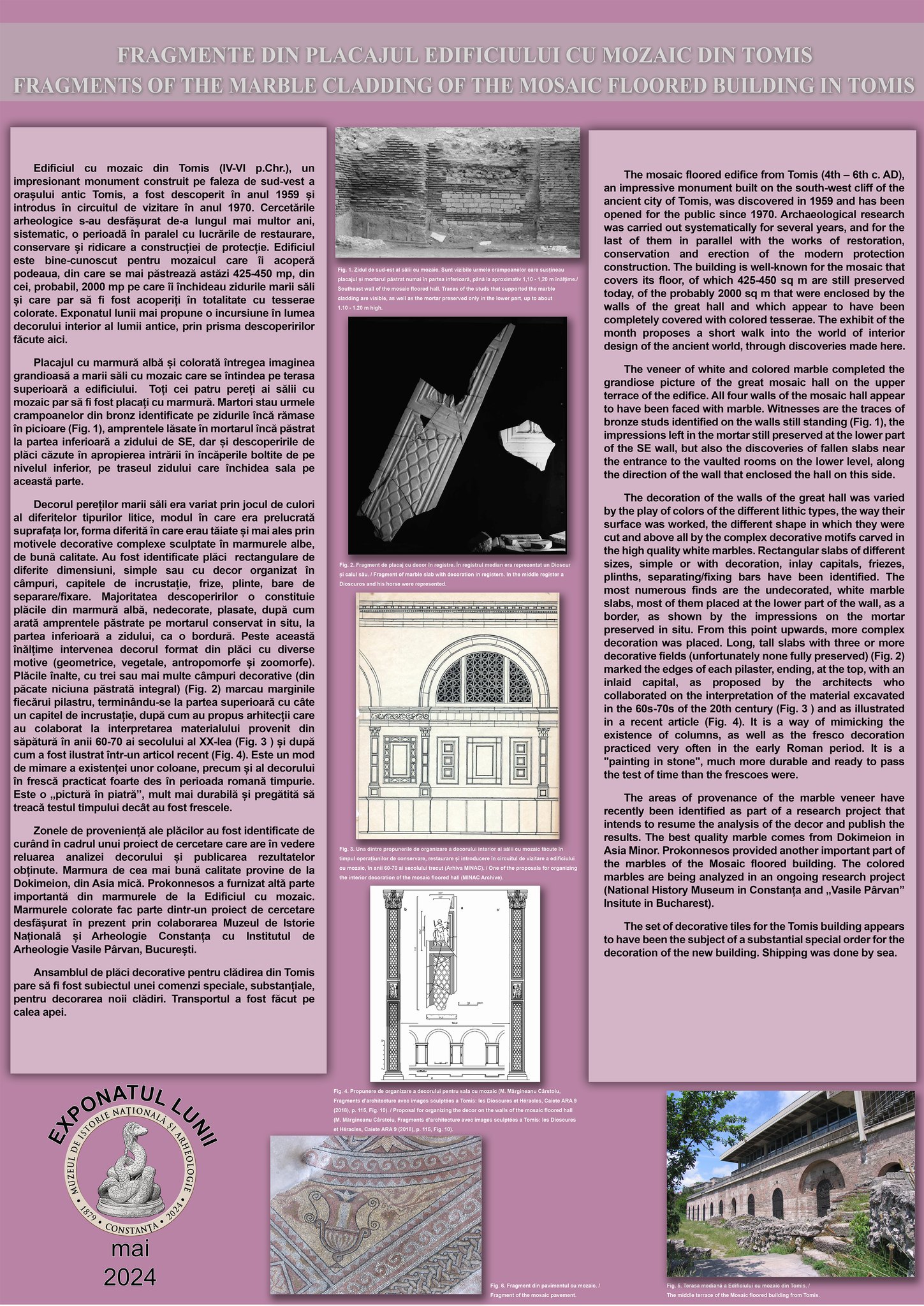
- This event has passed.
Constanța: Exponatul lunii mai 2024 la Muzeul de Istorie Națională și Arheologie Constanța – Statuete de teracotă descoperite la Tomis
1 mai - 31 mai

Exponatul lunii mai 2024. Fragmente din placajul Edificiului cu mozaic din Tomis
Edificiul cu mozaic din Tomis (IV-VI p.Chr.), un impresionant monument construit pe faleza de sud-vest a orașului antic Tomis, a fost descoperit în anul 1959 și introdus în circuitul de vizitare în anul 1970. Cercetările arheologice s-au desfășurat de-a lungul mai multor ani, sistematic, o perioadă în paralel cu lucrările de restaurare, conservare și ridicare a construcției de protecție. Edificiul este bine-cunoscut pentru mozaicul care îi acoperă podeaua, din care se mai păstrează astăzi 425-450 mp, din cei, probabil, 2000 mp pe care îi închideau zidurile marii săli și care par să fi fost acoperiți în totalitate cu tesserae colorate. Exponatul lunii mai propune o incursiune în lumea decorului interior al lumii antice, prin prisma descoperirilor făcute aici.
Placajul cu marmură albă și colorată întregea imaginea grandioasă a marii săli cu mozaic care se întindea pe terasa superioară a edificiului. Toți cei patru pereți ai sălii cu mozaic par să fi fost placați cu marmură. Martori stau urmele crampoanelor din bronz identificate pe zidurile încă rămase în picioare (Fig. 1), amprentele lăsate în mortarul încă păstrat la partea inferioară a zidului de SE, dar și descoperirile de plăci căzute în apropierea intrării în încăperile boltite de pe nivelul inferior, pe traseul zidului care închidea sala pe această parte.
Decorul pereților marii săli era variat prin jocul de culori al diferitelor tipurilor litice, modul în care era prelucrată suprafața lor, forma diferită în care erau tăiate și mai ales prin motivele decorative complexe sculptate în marmurele albe, de bună calitate. Au fost identificate plăci rectangulare de diferite dimensiuni, simple sau cu decor organizat în câmpuri, capitele de incrustație, frize, plinte, bare de separare/fixare. Majoritatea descoperirilor o constituie plăcile din marmură albă, nedecorate, plasate, după cum arată amprentele păstrate pe mortarul conservat in situ, la partea inferioară a zidului, ca o bordură. Peste această înălțime intervenea decorul format din plăci cu diverse motive (geometrice, vegetale, antropomorfe și zoomorfe). Plăcile înalte, cu trei sau mai multe câmpuri decorative (din păcate niciuna păstrată integral) (Fig. 2) marcau marginile fiecărui pilastru, terminându-se la partea superioară cu câte un capitel de incrustație, după cum au propus arhitecții care au colaborat la interpretarea materialului provenit din săpătură în anii 60-70 ai secolului al XX-lea (Fig. 3 ) și după cum a fost ilustrat într-un articol recent (Fig. 4). Este un mod de mimare a existenței unor coloane, precum și al decorului în frescă practicat foarte des în perioada romană timpurie. Este o „pictură în piatră”, mult mai durabilă și pregătită să treacă testul timpului decât au fost frescele.
Zonele de proveniență ale plăcilor au fost identificate de curând în cadrul unui proiect de cercetare care are în vedere reluarea analizei decorului și publicarea rezultatelor obținute. Marmura de cea mai bună calitate provine de la Dokimeion, din Asia mică. Prokonnesos a furnizat altă parte importantă din marmurele de la Edificiul cu mozaic. Marmurele colorate fac parte dintr-un proiect de cercetare desfășurat în prezent prin colaborarea Muzeul de Istorie Națională și Arheologie Constanța cu Institutul de Arheologie Vasile Pârvan, București.
Ansamblul de plăci decorative pentru clădirea din Tomis pare să fi fost subiectul unei comenzi speciale, substanțiale, pentru decorarea noii clădiri. Transportul a fost făcut pe calea apei.
Fig. 1. Zidul de sud-est al sălii cu mozaic. Sunt vizibile urmele crampoanelor care susțineau placajul și mortarul păstrat numai în partea inferioară, până la aproximativ 1,10 – 1,20 m înălțime.
Fig. 2. Fragment de placaj cu decor în registre. În registrul median era reprezentat un Dioscur și calul său.
Fig. 3. Una dintre propunerile de organizare a decorului interior al sălii cu mozaic făcute în timpul operațiunilor de conservare, restaurare și introducere în circuitul de vizitare a edificiului cu mozaic, în anii 60-70 ai secolului trecut (Arhiva MINAC).
Fig. 4. Propunere de organizare a decorului pentru sala cu mozaic (M. Mărgineanu Cârstoiu, Fragments d’architecture avec images sculptées a Tomis: les Dioscures et Héracles, Caiete ARA 9 (2018), p. 115, Fig. 10).
Fig. 5. Terasa mediană a Edificiului cu mozaic din Tomis.
Fig. 6. Fragment din pavimentul cu mozaic

Fragments of the marble cladding of the Mosiac floored building in Tomis.
The mosaic floored edifice from Tomis (4th – 6th c. AD), an impressive monument built on the south-west cliff of the ancient city of Tomis, was discovered in 1959 and has been opened for the public since 1970. Archaeological research was carried out systematically for several years, and for the last of them in parallel with the works of restoration, conservation and erection of the modern protection construction. The building is well-known for the mosaic that covers its floor, of which 425-450 sq m are still preserved today, of the probably 2000 sq m that were enclosed by the walls of the great hall and which appear to have been completely covered with colored tesserae. The exhibit of the month proposes a short walk into the world of interior design of the ancient world, through discoveries made here.
The veneer of white and colored marble completed the grandiose picture of the great mosaic hall on the upper terrace of the edifice. All four walls of the mosaic hall appear to have been faced with marble. Witnesses are the traces of bronze studs identified on the walls still standing (Fig. 1), the impressions left in the mortar still preserved at the lower part of the SE wall, but also the discoveries of fallen slabs near the entrance to the vaulted rooms on the lower level, along the direction of the wall that enclosed the hall on this side.
The decoration of the walls of the great hall was varied by the play of colors of the different lithic types, the way their surface was worked, the different shape in which they were cut and above all by the complex decorative motifs carved in the high quality white marbles. Rectangular slabs of different sizes, simple or with decoration, inlay capitals, friezes, plinths, separating/fixing bars have been identified. The most numerous finds are the undecorated, white marble slabs, most of them placed at the lower part of the wall, as a border, as shown by the impressions on the mortar preserved in situ. From this point upwards, more complex decoration was placed. Long, tall slabs with three or more decorative fields (unfortunately none fully preserved) (Fig. 2) marked the edges of each pilaster, ending, at the top, with an inlaid capital, as proposed by the architects who collaborated on the interpretation of the material excavated in the 60s-70s of the 20th century (Fig. 3 ) and as illustrated in a recent article (Fig. 4). It is a way of mimicking the existence of columns, as well as the fresco decoration practiced very often in the early Roman period. It is a „painting in stone”, much more durable and ready to pass the test of time than the frescoes were.
The areas of provenance of the marble veneer have recently been identified as part of a research project that intends to resume the analysis of the decor and publish the results. The best quality marble comes from Dokimeion in Asia Minor. Prokonnesos provided another important part of the marbles of the Mosaic floored building. The colored marbles are being analyzed in an ongoing research project (National History Museum in Constanța and „Vasile Pârvan” Insitute in Bucharest).
The set of decorative tiles for the Tomis building appears to have been the subject of a substantial special order for the decoration of the new building. Shipping was done by sea.
Fig. 1. Southeast wall of the mosaic floored hall. Traces of the studs that supported the marble cladding are visible, as well as the mortar preserved only in the lower part, up to about 1.10 – 1.20 m high.
Fig. 2. Fragment of marble slab with decoration in registers. In the middle register a Dioscuros and his horse were represented.
Fig. 3. One of the proposals for organizing the interior decoration of the mosaic floored hall (MINAC Archive).
Fig. 4. Proposal for organizing the decor on the walls of the mosaic floored hall (M. Mărgineanu Cârstoiu, Fragments d’architecture avec images sculptées a Tomis: les Dioscures et Héracles, Caiete ARA 9 (2018), p. 115, Fig. 10).
Fig. 5. The middle terrace of the Mosaic floored building from Tomis.
Fig. 6. Fragment of the mosaic pavement.